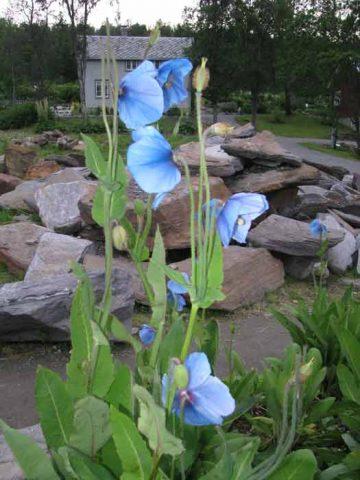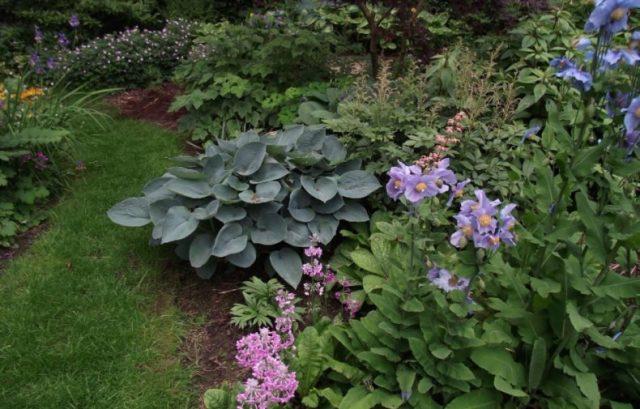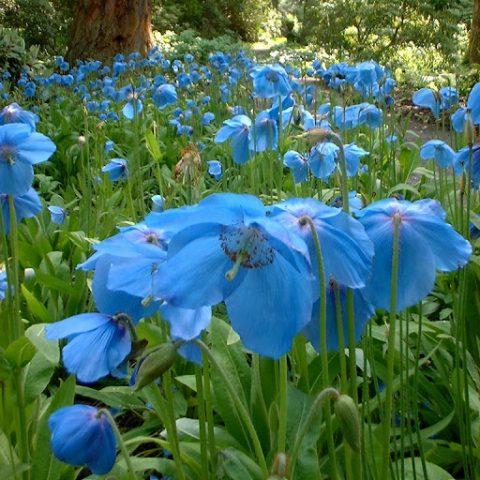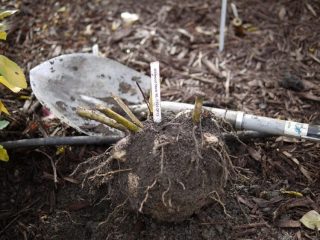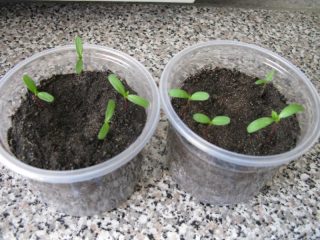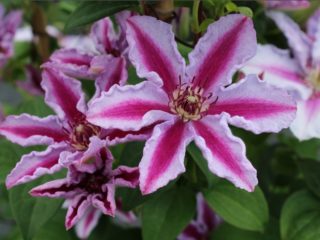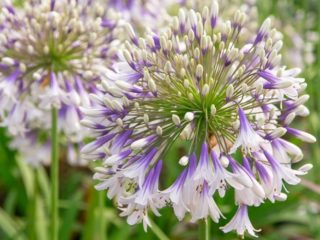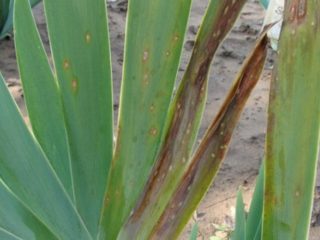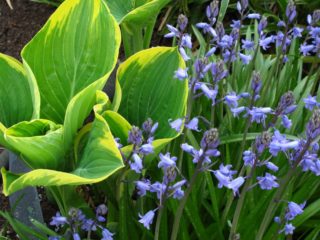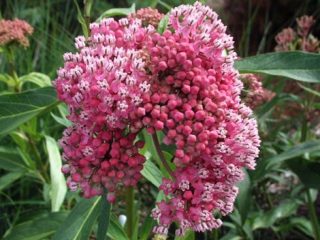Content
- 1 Description and characteristics of the plant
- 2 Types of meconopsis
- 3 Reproduction methods
- 4 Conditions for growing meconopsis
- 5 Planting and caring for meconopsis
- 6 Diseases and pests
- 7 Pruning and preparation for winter
- 8 Meconopsis in landscape design
- 9 Conclusion
- 10 Reviews of meconopsis or Himalayan poppy
Meconopsis or Himalayan poppy is a beautiful flower of azure, blue, and violet colors. Attractive due to its large size. It takes root well in any region in Russia, but requires regular moistening. It is used in single plantings and in compositions; it looks especially beautiful on the shore of a country pond.
Description and characteristics of the plant
Meconopsis, also called blue Himalayan poppy, is a perennial plant from the Poppy family (Papaveraceae). A distinctive feature is the beautiful and large flowers, reaching a diameter of 10–12 cm, and in some varieties up to 25 cm.
The stems are thin, depending on the type, their height ranges from 10 to 100 cm. The leaves are green, petiolate. They grow in rosettes.The foliage and stem of Meconopsis are often covered with white or yellow down. The root system can be either taproot or fibrous, quite developed, with several growth points.
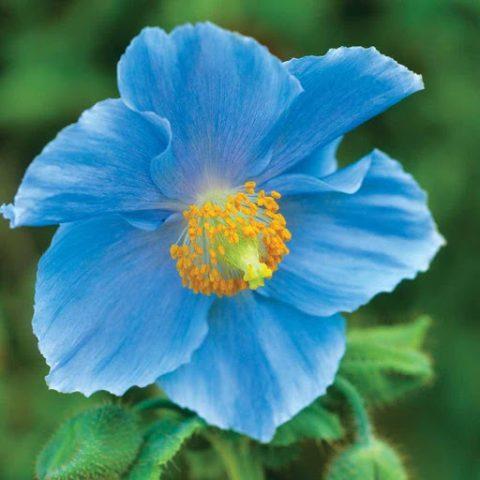
The petals of the Himalayan poppy are a pleasant azure color, although there are other shades: blue, violet, blue, lavender, yellow, white
Flowers are six-petalled. The stamens are light orange in color and contrast well with the petals. Meconopsis flowering lasts 3–4 weeks (from mid-June to mid-July). By the end of summer, the Himalayan poppy bears fruit - dry capsules with small oily seeds.
In nature, the plant is found in the highlands of India, Nepal, Bhutan, and China. Also grows in the Alps at an altitude of 3–5.5 km. Himalayan poppies are often found in other parts of the world: Alaska, Canada, Scandinavia, Japan, New Zealand, Australia.
In Russia, there are also wild Himalayan poppies - all of them belong only to the species Meconopsis alphabet.
Types of meconopsis
There are 45 species in the genus Meconopsis. The most famous of them are cultivated: alphabetic, Sheldon and Cambrian.
Meconopsis alphabetifolia
Meconopsis betonicifolia is a beautiful species of Himalayan poppy with blue flowers, the diameter of which reaches 9–10 cm. The first inflorescences appear in June, and they last for 5–7 days, after which they fade. The duration of flowering of the crop is up to one month. When caring for this plant in the first year, all buds are removed before they open. Otherwise, meconopsis alphabetic (betonyfolia) will die in the same season, i.e. behaves like an annual plant.

Peduncles of the betonicifolia variety reach a height of 80–90 cm
Meconopsis Sheldon
The description of Sheldon's meconopsis (Meconopsis x sheldonii) states that it is a hybrid variety with soft blue flowers. Feels great in partial shade, on moist and loose soils. Himalayan poppy tolerates drought well. The culture cannot withstand prolonged stagnation of moisture.
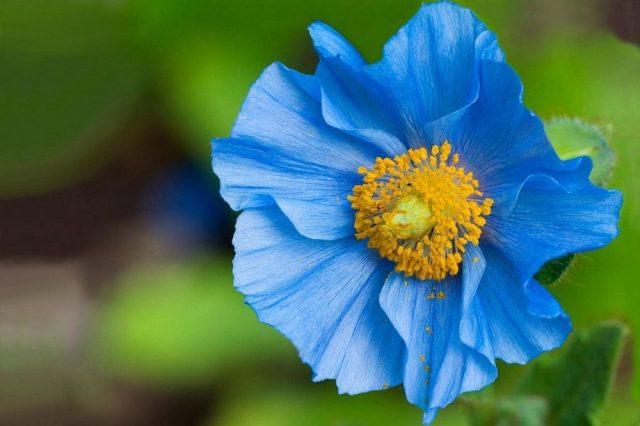
The Sheldon variety has large flowers up to 10 cm in diameter
Meconopsis Cumbrian
Meconopsis cambrica is a beautiful variety of Himalayan poppy with yellow flowers. Grows in height up to 30–40 cm. 4
Cumbrian meconopsis is characterized by high winter hardiness - it can withstand frosts down to -34 °C
Reproduction methods
Himalayan poppy can be grown from seeds you collect yourself. Other propagation methods are also available: dividing the bush and cuttings.
Growing from seeds
Meconopsis seeds are collected in the fall, when the capsules are completely dry. Then they are stored in the refrigerator, simulating sowing conditions before winter (this procedure is called stratification). Then meconopsis is sown for seedlings. Grow at home at temperatures below room temperature (up to +15 °C). The seedlings are transferred to open ground closer to mid-May, when the threat of return frosts will be minimized.
This method of propagation is not used for hybrids, since the flowers may not retain the characteristics of the mother plant. Therefore, it is better to breed them by dividing the bush.
Dividing the bush
It is best to carry out the procedure in early spring, when meconopsis has not yet begun to grow (late March). If the deadline is missed, you can do this in August, and if the month is hot, then in September.
You can divide adult Himalayan poppy bushes that are 2-3 years old. They are dug up, shaken off the ground and straightened out the roots. Then the bush is divided into several plants so that each part has 1-2 buds or emerging rosettes. The delenki are planted in a new place, watered abundantly and mulched. When planting in autumn, be sure to cover it with a layer of litter, peat, and sawdust.
Cuttings
Himalayan poppy can be taken from cuttings. To do this, at the end of spring or early summer, green shoots 10–15 cm long are cut. They are immersed for several hours in a solution that improves root formation (Epin, Zircon).
Then they are planted in moist fertile soil in a flower bed. Immediately cover with a jar, which is periodically removed for ventilation. Moisturize regularly. It is also necessary to create light shading. By autumn, cuttings of Himalayan poppy will give roots. At this point, they can be transplanted to a new place (or left in the same place) and mulched for the winter.
Conditions for growing meconopsis
Himalayan poppies tolerate short periods of shade well. For planting, it is not recommended to choose open areas with direct sunlight, since the heat has a bad effect on the flower. Also, the place should be well moistened. It is advisable to plant the crop on the shore of a reservoir.
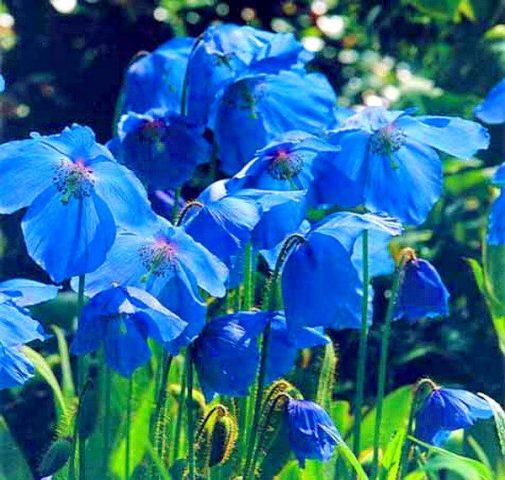
The optimal soil for growing Himalayan poppy is fertile loamy or sandy loam.
If the soil is depleted, then when digging a flower bed in the fall, add 30–40 g of complex mineral fertilizer or 3–7 kg of humus per 1 m2 to the ground. After planting, provide moist conditions, preventing the soil from drying out and cracking. Feeding is carried out periodically.
Himalayan poppy seedlings can be grown in a mixture of peat and perlite (1:1).You can also make a mixture of turf soil with peat and humus (2:1:1) or purchase a universal soil for the crop.
When to sow seeds for seedlings and in open ground
Himalayan poppy seeds are sown for seedlings as early as late February or early March. In the south you can start a week earlier, and in regions with cool summers (Ural, Siberia) - a few days later.
The seedlings are transferred to open ground 2.5 months after sowing, i.e. approximately in mid-May. At this moment, the daytime temperature should not be lower than +17 °C. It is necessary to monitor the weather forecast. The threat of return frosts must pass, otherwise the plants will die.
Planting and caring for meconopsis
Preparations for planting Himalayan poppy begin at the end of winter. The seeds are soaked, then planted as seedlings and grown at home until the beginning of May. After this, they are transferred to the flowerbed.
How to sow and grow meconopsis from seeds
Growing Himalayan poppy meconopsis from seeds begins at the end of January. The seeds are placed on a damp paper towel, covered with the same layer on top and placed in a plastic bag. Sent to the refrigerator (where they were stored after the autumn harvest or purchase) and kept at temperatures up to +4 °C for 5–6 weeks, i.e. until mid-February.
At this time, they begin to prepare containers for Himalayan poppy seedlings. These can be plastic containers or wooden boxes. To disinfect, they are rinsed with boiling water, and the soil is watered with a 1% solution of potassium permanganate or placed in the freezer for several days.

Himalayan poppy seedlings can be grown in cassettes
A layer of small pebbles is poured into the bottom of the planting container, then the soil mixture is added.Sow the seeds to a depth of 1–1.5 cm, water with a sprayer and place in a cool place with a temperature of +10–12 °C. Cover with a film with holes, which is periodically removed for ventilation. Provide diffused light. After two leaves appear, Himalayan poppy seedlings are planted in peat pots or other containers. All this time, the temperature in the greenhouse should not rise above +15 °C.
Planting seedlings and subsequent care
Seedlings are transplanted into the ground in May, although some gardeners practice growing at home until the beginning of August, after which they transfer the seedlings to a permanent place. The Himalayan poppy planting algorithm is standard:
- In a previously prepared (dug up and fertilized) flower bed, several shallow holes are formed at a distance of 30–50 cm. Planting density depends on the variety, as well as on the design of the future flower garden.
- The seedlings are planted together with a lump of earth.
- Cover it with turf soil and humus and tamp it down a little.
- Water and mulch with peat, sawdust, straw or wood chips.
After planting meconopsis in open ground, you must follow several rules and care tips:
- It is very important to ensure abundant watering of the Himalayan poppy - at least once a week, and in drought - 2-3 times.
- In order for the soil to retain moisture longer, there should always be a layer of mulch made of peat, sawdust or other materials on it.
- The next day after watering or heavy rain, it is advisable to loosen the soil, otherwise over time it will become crusty.
- Fertilizing is applied in May and June - it can be organic or a complex mineral composition. But if the mulch contains peat or humus, you can skip the first application.
Diseases and pests
Meconopsis has good immunity.The plant tissue contains toxic substances that repel many pests. But sometimes poppy can suffer from powdery mildew (a grayish coating forms on the leaves, after which they curl). For treatment and prevention, bushes are treated with fungicides: Bordeaux mixture, Fitosporin, Tattu, Maxim, Fundazol.
Of the insects, only aphids can harm the crop. It is quite easy to deal with it by spraying the bushes with insecticides: “Biotlin”, “Green Soap”, “Confidor”, “Decis”, “Fufanon”.
You can also use home remedies: a solution of soap with ash, an infusion of tobacco dust, a decoction of marigold flowers, an infusion of onion peels, garlic cloves and many others.

Processing of Himalayan poppy is carried out in the evening in calm and dry weather.
Pruning and preparation for winter
Himalayan poppy is a winter-hardy plant. In the fall, it is enough to simply trim it to a stump, leaving stems 3–4 cm high. This can be done in early October, i.e., on the eve of the first frost. Then the seedlings are mulched with leaves, straw, and sawdust. In the southern regions you can be left without shelter.
Meconopsis in landscape design
Himalayan poppy looks great near bodies of water. If there is no small pond at the dacha, the flower can be planted in a flower bed, rock garden, rock garden, or on a rocky hill.
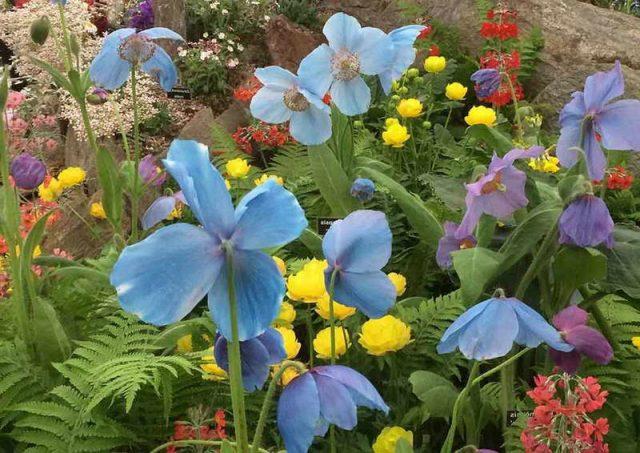
Himalayan poppy is used both in single plantings and in combination with various meadow grasses
The culture looks good with fern, hostas and hydrangea. Options for using meconopsis with photos will help when planning your garden design:
- Himalayan poppy on a rocky flower bed.
- Composition with hosts.
- Single landing.
Conclusion
Meconopsis or Himalayan poppy is one of the unassuming flowers that are used to decorate the garden. In nature, the plant is found in the mountains, so it is well adapted to the climatic conditions of Russia.
Reviews of meconopsis or Himalayan poppy
